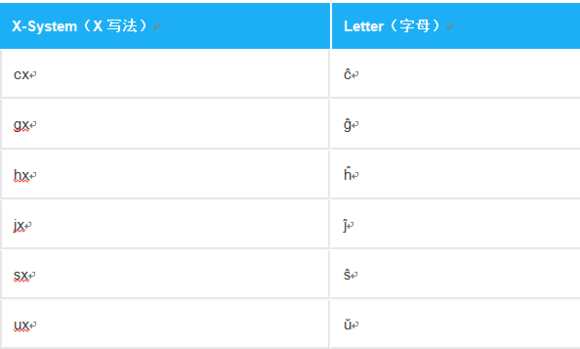多邻国世界语tips and notes基础篇(中英对照) |
您所在的位置:网站首页 › 多邻国读音标准吗 › 多邻国世界语tips and notes基础篇(中英对照) |
多邻国世界语tips and notes基础篇(中英对照)
极其不正经的前言(其实根本就不是前言) 问:为什么要翻译呢? 答:我最近在多邻国学世界语,发现里面只有英文版的,于是觉得这可能对英语不太好的同学造成不便,于是就试着翻译了,虽然英语不好的同学可能选用中文的教材而不会去不会去多邻国_(:3」∠)_。另外就是想提高一下自己的英语水平_(:3」∠)_(虽然这是我最初的目的),翻译水平比较渣,喜欢的话点个赞,不喜欢的话........别打我就好了_(:3」∠)_ 问:那说下用英语学世界语的感受吧答:怎么说呢?对我来说~~非常非常好吃,但是..... 问:跑题了喂!(╯°口°)╯(┴—┴ 答:好了,我不乱扯了_(:3」∠)_ ,感觉英语的教材逻辑性比较强,更加便于理解,毕竟世界语和英语是同一个语系的,在某些比较相似,具体的大家可以在习题或者例句中发现的。好了,废话就这么多了,直接进正题吧(°∀°)ノ Grammar notes will be more helpful once you have a context for understanding them, so if you find you're having trouble with the lessons, these notes should be more helpful to you. 一旦你有了语境去理解它们,语法注释将会对你更加有帮助,所以,如果你发现你在课程上出现问题,这些注释对你有帮助 SOMESIMPLE ESPERANTO RULES (一些简单的世界语规则) Each letter has a unique and separate sound. 每个字母拥有唯一的读音 For example: longa is pronounced "lon-ga". Both k and n are pronounced in knabo. 例如longa读作“lon-ga”,“k”和“n”在knabo一词里面也要发音 The emphasis in every word is always on the next-to-last syllable. 重读都是落在每个单词的倒数第二个音节 For example: all 2-syllable words have the emphasis on the first syllable, as in viro, and all 3-syllable words have the emphasis onthe middle syllable, as in knabino. 例如,像viro那样,所有双音节词的重读都落在第一个音节。所有三音节词的重读落在中间的音节上,比如“knabino” All present tense verbs end in -as, so there are no verb conjugations. Examples:estas, laboras.Yay! 动词的现在时都是以“-as”结尾的,没有动词变形,例如:estas,laboras。 All singular nouns, suchas knabo and virino, end in -o. This includes names ofcities and countries, such as Francio (France). 所有的单数名词,例如knabo和virino,以-o为结尾。这规则在城市和国家的名字亦不例外Francio,法国。 The definite article ("the" in English) is la inEsperanto. la是世界语里面的定冠词(英语里面是the) For example: la viro = the man. 例如: la viro = the man(特指的男人) Indefinite articles ("a" and"an" in English) are not used in Esperanto. 世界语里面并不使用不定冠词(英语里的a 和an) For example: viro = a man. 例如:viro = a man (一个男人) -in is the feminine suffix: viro = man, virino = woman; knabo =boy, knabino = girl. –in是阴性后缀:viro=man(男人)virino=woman(女人);knabo=boy(男孩),knabino=女孩。 Remember that all singular nouns end in -o, so the full ending is -ino. 另外要记住,所有的单数名词的结尾都是以-o结尾的,所以写的时候记得写成-ino (。・ω・。) ESPERANTO ALPHABET (世界语字母表) The Esperanto alphabet has 28 letters. They include all the letters of the English alphabet,except for Q, W, X and Y. A few letters have accent marks. 世界语有个字母,除了QWXY之外,英语字母都包含在其中,少数字母拥有重音符号 If you are spelling an Esperanto word out loud, the name of each consonant is the sound that letter makes, followed by -o: B = bo, S = so etc. 如果你用口述方式拼出世界语单词,每一个辅音的名称要把它的发音加-o读出来:B=bo ,S=so 如此类推 The name of each vowel is the soundthat letter makes. 元音的名字就是它字母的本身 Here are approximateEnglish equivalents for each vowel (下面是和世界语元音读法差不多的英语读音)  The letters C and J (字母C和J)  Here are four of the accented letters: (下面是四个重音字母)  ESPERANTOKEYBOARD (世界语输入法)Toobtain an Esperanto keyboard that will allow you to easily type these special characters, please refer to our forum by following the link below: 获得世界语输入法能够让你更容易地打出这些重音字母,请参考我们的论坛:https://www.duolingo.com/comment/8841170 WHAT IF IDON'T WANT TO INSTALL A KEYBOARD JUST FOR THIS COURSE? 如果我不想就为了上这堂课而安装输入法呢? Duolingo recognizes the x-system, alternative method of entering the accented Esperanto characters. 多邻国能够辨识X写法,这是一个典型的世界语重音字母输入法  To use thex-system, simply type the letter that requires the accent followed by an x: 使用X写法输入字母。只需用X代替重音符号就好了 Note that Duolingo will not convert accented characters entered via the x-system in theanswer immediately when typed, but will recognize them when they are submittedfor checking. 注意一下:多邻国不会马上将你用X写法输入的重音字母自动转换为正常的重音字母。不过它会在上传的答案中识别出来的。 ESTAS Estas means am, is, or are. It is the present tense of the verb esti, to be. It is used in sentences like La nokto estas varma. (The night is hot.) or Adamo estas viro. (Adam is a man.) to assign a property or identity to someone or something.Estas在英文意思是am,is或者are。它是esti的动词现在时,英文意思为to be。它在句子中用来指定某种事物的属性或者某个人的身份。例如La nokto estasvarma. (这是个炎热的夜晚)或者Adamo estasviro. (亚当是个男人.) It can also be used to state the existence of someone or something: Estas viro en la parko. (There is a man in the park.), or Estas nokto. (It is night.) 它也能用于陈述某人或者某物的存在: Estas viro enla parko. (公园里有个男的)或者 Estas nokto. (这是个夜晚) From these examples we can see that when it is the first word in a sentence, Estas means "There is" or "It is". 从例子中我们可以看出,当estas放在句子开头时,它的意思相当于英语里的“there is ”或者“it is” In these cases the subject comes after esti and, in contrast to English, we don't use "ĝi" (it) because the verb already has a real subject after it : 这些例子中,主语跟在esti的后面,这与英语相反。但我们不能用"ĝi"(it),因为动词后面已经有真正的主语了:  Note: Do NOT say "Ĝi estas varma nokto". Ĝi (it) in Esperanto always stands for a noun, but in this sentence it doesn't stand for anything at all. The subject of the sentence is varma nokto. 注意:所以别说"Ĝi estas varma nokto"。Ĝi在世界语里面通常指代的是一个名词,但在刚才的句子里面它并不能指代任何东西,因为这句话的主语是varma nokto。 ADJECTIVES(形容词)Adjectives are words like fast, good, or big, which modify a noun.Remember that a noun always ends in -o in Esperanto.Adjectives, on the other hand, end in -a: rapida =fast, granda = big, bona = good 形容词是用来修饰名词的词,例如英语里的fast(快的),good(好的)和big(大的),你们要记得在世界语里面名词是以“-o”结尾的。而形容词,是以“-a”结尾的:rapida=快的,granda=大的,bona=好的 In Esperanto, the adjective may be placed either before or after the noun with no change in meaning. "Bona viro" and "viro bona"both mean "a good man" and both are correct. In practice, most people place the adjective before the noun. 在世界语中,形容词放在名词前面和后面都不会改变句子的意思,“a good man(一个好男人)”翻译成"Bona viro" 或者"viro bona"都是没问题的。不过在使用时,大多数人都是把形容词放在名词前的。 AFFIXES(词缀) mal- is a prefix that means "the opposite of". Please note that while malbona means bad, mal- by itself does not mean bad (as it does in some other languages). mal-这一前缀意思是“与之相反”。注意:尽管malbona是坏的意思,但是mal-它本身的意思并不是“坏的”(正如它和其他语言里一样) -ej is a suffix usedto indicate a place: -ej这一后缀用来指明地点 kafo =coffee; kafejo = café (a place where you drink coffee, and otherdrinks.) kafo=咖啡;kafejo=咖啡馆(你喝咖啡或者其他饮料的地方) ADVERBS(副词) Adverbs (usually -ly wordsin English) modify verbs and adjectives. 副词(通常在英语里是-ly结尾的词)是用来修饰动词和形容词的词 In Esperanto they almost always end in -e. Examples:rapide = quickly, malrapide = slowly, bone =well 在世界语里它大多数是以“-e”结尾的,例如rapide=讯速地,malrapide=缓慢地,bone=好 PREPOSITIONS(介词)The noun following a preposition normally takes a simple-o ending (-oj in the plural). Other endings will be explained later. 跟着介词的名词通常是简单地带着-o结尾(-oj是名词复数)。其他结尾将会在后面提及 For example(例如): La virinoestas en la kafejo. The woman is in the café. (那位女士在咖啡馆里) Ni iras al la parko.We go to the park. (我们去公园) ĉu(是否/吗)ĉu introduces a yes/no question, or one that poses a choice between options. ĉu用来引入是或否的问题,或者是在两个意见中作出选择 Unlike in English, the subject and verbdo not need to be inverted: 不像英语,主语和动词的位置不需要颠倒:   Expressions With Ĉu(关于ĉu的解释)Ĉu Ne? = Isn't It? Ĉu Ne? =有没有?是吧?有嘛?Ĉu? = Really? Ĉu? =真的吗? 原文来自: http://www.duolingo.cn/skill/eo/Basics-1 http://www.duolingo.cn/skill/eo/Basics-2 翻译:vanilo(好吧....其实不想让人家产生误会....) 封面:成为彩虹吧! 另外,这是在度娘那里转过来的(虽然度娘那里也是我发的2333)总体上是调整了一下顺序(毕竟...我发布这一篇译文的时候度娘秒吞了,然后造成了顺序的混乱)也许还有一些单词是粘在一起的..... 为什么这么晚还不休息?额....其实是睡不着啦~~~平时11:30左右就上床睡觉了 ↑或许这就是为什么我快200斤的原因吧..... |
【本文地址】
今日新闻 |
点击排行 |
|
推荐新闻 |
图片新闻 |
|
专题文章 |